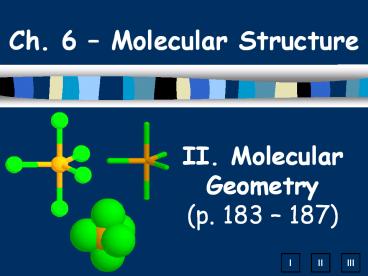II. Molecular Geometry (p. 183 - PowerPoint PPT Presentation
1 / 22
Title:
II. Molecular Geometry (p. 183
Description:
Ch. 6 Molecular Structure II. Molecular Geometry (p. 183 187) A. VSEPR Theory Valence Shell Electron Pair Repulsion Theory Electron pairs orient themselves in ... – PowerPoint PPT presentation
Number of Views:179
Avg rating:3.0/5.0
Title: II. Molecular Geometry (p. 183
1
II. Molecular Geometry(p. 183 187)
- Ch. 6 Molecular Structure
2
A. VSEPR Theory
- Valence Shell Electron Pair Repulsion Theory
- Electron pairs orient themselves in order to
minimize repulsive forces. - Used to predict the geometry of complicated
molecules.
3
A. VSEPR Theory
- Types of e- Pairs
- Bonding pairs - form bonds to central atom
- Lone pairs nonbonding e- around central atom
4
A. VSEPR Theory
- Repulsive forces between electrons cause them to
stay as far away from each other as possible.
H2O
5
How pairs of electrons behave
- The number of paired and unpaired electrons
determine the shape of the molecule. - Lone pairs occupy the space in the same way
paired e- do.
6
B. Determining Molecular Shape
- Draw the Lewis Diagram.
- Tally up e- pairs on central atom.
- double/triple bonds ONE pair
- Shape is determined by the of bonding pairs and
lone pairs. - Chart on page 186
7
Chart
- A Central atom
- B Atoms bonded to central atom
- E Unshared pairs of electrons
- Subscripts refer to the number of each.
8
C. Common Molecular Shapes
- 2 total
- 2 bond e-
- 0 lone e-
LINEAR 180
9
C. Common Molecular Shapes
- 3 total
- 3 bond e-
- 0 lone e-
TRIGONAL PLANAR 120
10
C. Common Molecular Shapes
- 3 total
- 2 bond e-
- 1 lone e-
BENT lt120
11
C. Common Molecular Shapes
- 4 total
- 4 bond e-
- 0 lone e-
TETRAHEDRAL 109.5
12
C. Common Molecular Shapes
- 4 total
- 3 bond e-
- 1 lone e-
TRIGONAL PYRAMIDAL 107
13
C. Common Molecular Shapes
- 4 total
- 2 bond e-
- 2 lone e-
BENT 104.5
14
C. Common Molecular Shapes
- 5 total
- 5 bond e-
- 0 lone e-
TRIGONAL BIPYRAMIDAL 120/90
15
C. Common Molecular Shapes
- 6 total e-
- 6 bond e-
- 0 lone
OCTAHEDRAL 90
16
D. Examples
- PF3
4 total 3 bond 1 lone
TRIGONAL PYRAMIDAL 107
17
D. Examples
- CO2
2 total 2 bond 0 lone
LINEAR 180
18
Predict the shape of the following
- SO2
- CI4 (carbon and iodine)
- BCl3
19
Answers
- Bent or angular
- Tetrahedral
- Trigonal-planar
20
Two ways that atoms will not be able to obey the
octet rule.
- 1.Having too few valence electrons to ever obtain
an octet. - Hydrogen, Beryllium and Boron have two few
valence electrons to ever obtain a full octet.
21
See This
- Hydrogen can have at most 2 valence electrons
after it shares its electron with another atom. - Beryllium will have 4 valence electrons after it
has finished bonding. - Boron will have 6 valence electrons after it
shares its valence electrons with other atoms.
22
- 2.Expanding the octet to have 10, 12 or 14
valence electrons instead of 8. - Elements in periods 3, 4, 5, 6 and 7 can expand
their octet to have 10, 12, or 14 valence
electrons. - See how this can happen.































